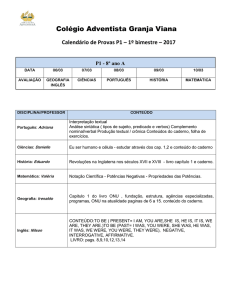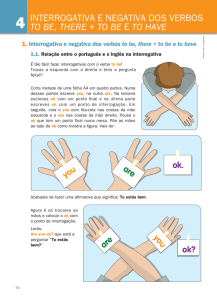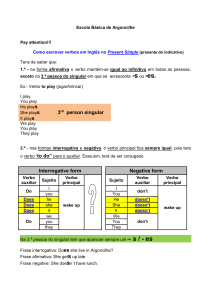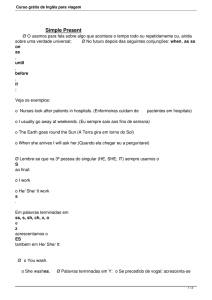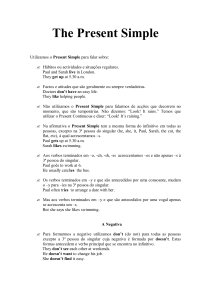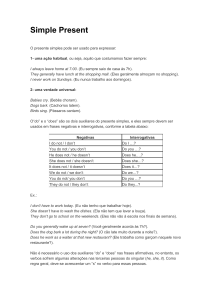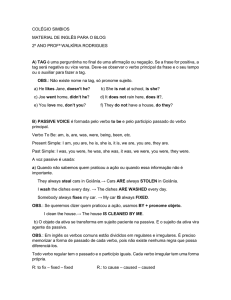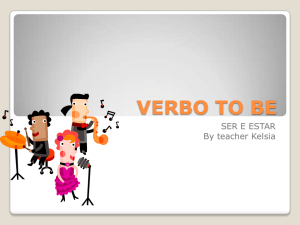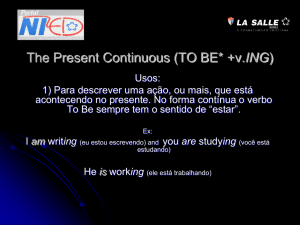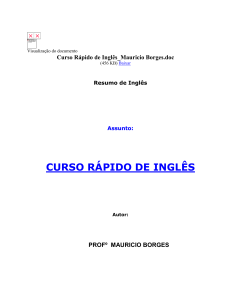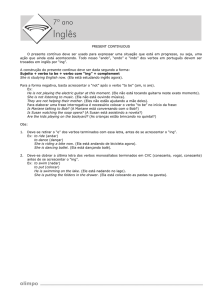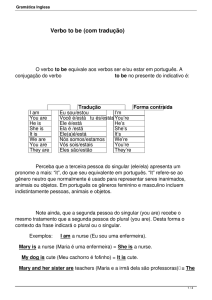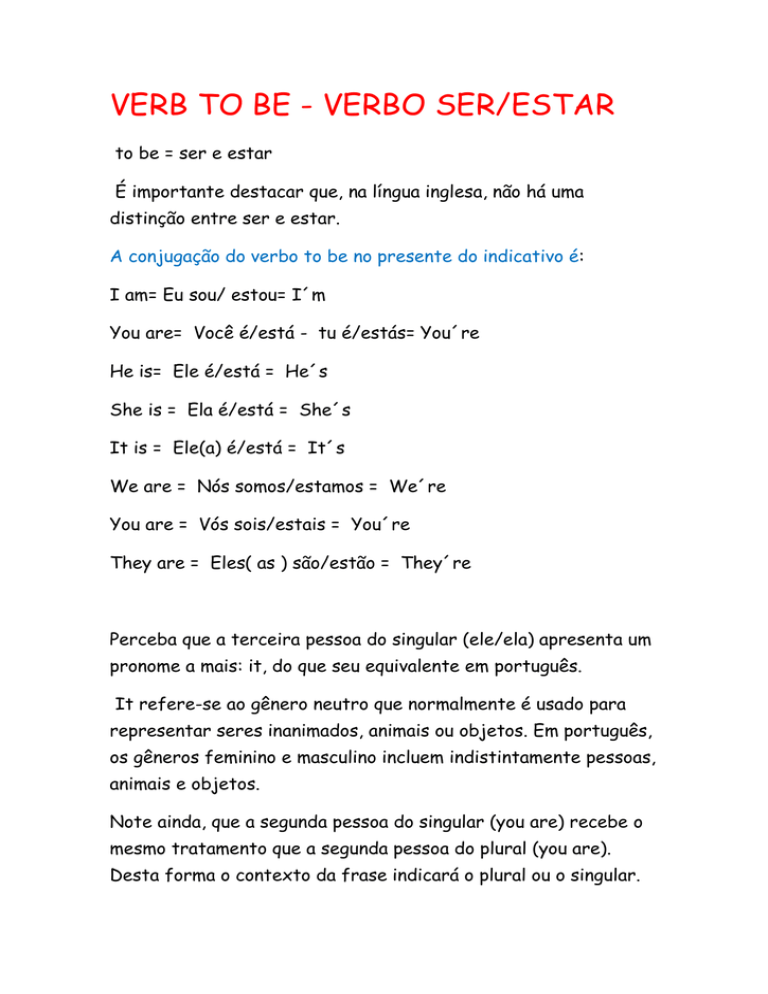
VERB TO BE - VERBO SER/ESTAR
to be = ser e estar
É importante destacar que, na língua inglesa, não há uma
distinção entre ser e estar.
A conjugação do verbo to be no presente do indicativo é:
I am= Eu sou/ estou= I´m
You are= Você é/está - tu é/estás= You´re
He is= Ele é/está = He´s
She is = Ela é/está = She´s
It is = Ele(a) é/está = It´s
We are = Nós somos/estamos = We´re
You are = Vós sois/estais = You´re
They are = Eles( as ) são/estão = They´re
Perceba que a terceira pessoa do singular (ele/ela) apresenta um
pronome a mais: it, do que seu equivalente em português.
It refere-se ao gênero neutro que normalmente é usado para
representar seres inanimados, animais ou objetos. Em português,
os gêneros feminino e masculino incluem indistintamente pessoas,
animais e objetos.
Note ainda, que a segunda pessoa do singular (you are) recebe o
mesmo tratamento que a segunda pessoa do plural (you are).
Desta forma o contexto da frase indicará o plural ou o singular.
Nas frases que estão na forma negativa aplica-se a ordem:
“sujeito + verbo to be+ not + complemento.
I am not= Eu não sou / não estou =I ain´ t = I´m not
You are not = Você não é / não está = You aren´t = You´re not
He is not= Ele não é / não está =He isn´t = He´s not
She is not= Ela não é / não está =She isn´t = She´s not
It is not= Ele(a) não é / não está= It isn´t =It´s not
We are not =Nós não somos / não estamos =We aren´t = We´re
not
You are not =Vocês não são / não estão =You aren´t = You´re not
They are not= Eles não são / não estão =They aren´t = They´re
not
Exemplos:
They are not right.(Eles não estão certos).
Paul is not tall. (Paulo não é alto).
I am not sad. (Eu não estou triste).
Lisa is not Japanese. (Lisa não é japonesa).
Ao usarmos o verbo to be na forma interrogativa, geralmente
empregamos a ordem: “verbo + sujeito + complemento”.
Exemplos:
Are you hungry? (Você está com fome?).
Are they American?(Eles são americanos?).
Is he a singer? (Ele é um cantor?).
Is he the doctor? (É ele o médico?).
Am I late? (Eu estou atrasado?).
Is your dog tired? (O seu cachorro está cansado?).
Nas perguntas negativas com o verbo to be, utiliza-se: “verbo na
forma contraída + sujeito + complemento” .
Aren’t you hungry? (Você não está com fome?).
Isn’t the teacher angry? (A professora não está nervosa?).
Isn’t your father a doctor? (Seu pai não é um médico?
).
VERB THERE TO BE (PRESENT
TENSE)
O verbo there to be é o verbo haver, existir em inglês.
Ex: There is a car outside . (singular)
There are many cars outside. (plural)
Obs.: "Ter" no sentido de "possuir"
é expressado pelo verbo HAVE.
Ex: I have a car. (eu tenho um carro)
Affirmative form
singular .......there is ...há ,existe
Ex: There is a woman in the car.
plural .........there are... há existem
Ex: There are two women in the car.
Observação: O verbo muda de There is para there are de acordo
com o seu complemento:
a woman é singular
two women é plural
Você também poderá usar a forma contraída there's e there're.
Exs: There's a woman in the car.
There're two women in the car.
Negative form
singular... there is no t= There isn't .... não há, não existe
Ex: There is not a beach in this place.
plural..... there are not = there aren't....não há , não existem
Ex: There are not beaches in this place.
Interrogative form
singular ....is there...?..... há...? existe...?
Is there a Portuguese teacher in the classroom?
No, there isn't. There is an English teacher.
plural ......are there...?..... há...? existem...?existem...?
Ex: How many students are there in the classroom?
Simple Present
O presente simples é usado para expressar:
1- uma ação habitual, ou seja, aquilo que costumamos fazer
sempre:
2- uma verdade universal:
O“do” e o “does” são os dois auxiliares do presente simples, e
eles sempre devem ser usados em frases negativas e
interrogativas, conforme a tabela abaixo:
Negativas
Interrogativas
I do not / I don’t
Do I …?
You do not / you don’t
Do you …?
He does not / he doesn’t
Does he….?
She does not / she doesn’t
It does not / it doesn’t
We do not / we don’t
Does she…?
Does it…?
Do we…?
You do not/ you don’t
Do you …?
They do not / they don’t
Do they...?
Não é necessário o uso dos auxiliares “do” e “does” nas frases
afirmativas, no entanto, os verbos sofrem algumas alterações nas
terceiras pessoas do singular (he, she, it). Como regra geral,
deve-se acrescentar um “s” no verbo para essas pessoas.
No entanto, existem algumas exceções que se referem às
terceiras pessoas do singular (he, she, it). São elas:
1- Quando o verbo terminar em “y” precedido de consoante, tirase o “y” e acrescenta-se “ies”.
2- Quando os verbos terminarem em “ss”, “sh”, “ch”, “x” e “o”,
acrescenta-se “es”.
VERB TO HAVE ( PRESENT TENSE)
AFFIRMATIVE FORM
I have (eu tenho)
you have (você tem )
he has (ele tem)
she has (ela tem )
it has (ele / ela tem)
we have (nós temos)
you have (vocês têm)
they have (eles / elas têm)
Observe que o verbo será sempre has para he, she e it.
Importante:
Usa-se o verbo ter para dizer
a idade em língua portuguesa; em inglês, usa-se o verbo to
be:
aprenda a aceitar as diferenças lingüísticas.
How old are you?(Quantos anos você tem?)
I am twenty years old.(Eu tenho vinte anos.)
Use o verbo to be para falar das seguintes sensações físicas:
ter fome / estar com fome ...to be hungry Ex: I am hungry.
ter sono /estar com sono ....to be sleepy Ex: Peter is sleepy.
ter sede / estar com sede.... to be thirsty Ex:The boys are
thirsty.
ter medo / estar com medo ....to be afraid Ex:They are afraid of
spiders.
Quando usado isoladamente, o verbo to have significa "ter",
"possuir".Ele não significa haver( existir).Para dizer haver no
sentido de existir, use there to be.
Ex: Em Português posso dizer:
Tem uma pessoa estranha aqui ou há uma pessoa estranha
aqui.(melhor Português).
Em inglês dizemos:
There's a strange person here.
O verbo to have é usado para falar das refeições:
Exemplos:
to have coffe, beer, cigarretes... tomar café, cerveja /
fumar cigarros
to have breakfast... tomar café da manhã
to have lunch... almoçar
to have dinner... jantar
to have a shower, a bath... tomar banho
to have a good time... divertir-se
Negative form
I don't have (eu não tenho)
you don't have (você não tem)
he doesn't have (ele não tem )
she doesn't have (ela não tem)
it doesn't have (ele / ela não tem)
we don't have (nós não temos)
you don't have (vocês não têm )
they don't have (eles / elas não têm )
O verbo é sempre have na forma negativa. O que muda é como
dizer não: use doesn't para he, she e it, e don't para as demais
pessoas.
Exemplos
I don't have a house.
You don't have two daughters.
He doesn't have a car.
Interrogative form
do I have...? (eu tenho...?)
do you have...? (você tem...? )
does he have...? (ele tem...?)
does she have...? (ela tem...?)
does it have...? (ele / ela tem...?)
do we have...? (nós temos...? )
do you have...? (vocês têm...?)
do they have...? (eles / elas têm...?)
Exemplos:
Do you have a dog?
Does she have long hair?
Does he have a car?
Present Continuous
O presente contínuo deve ser usado para expressar uma
situação que está em progresso, ou seja, uma ação que ainda está
acontecendo. Todo nosso “ando”, “endo” e “indo” dos verbos em
português devem ser trocados em inglês por “ing”.
A construção do presente contínuo deve ser dada segundo a
forma:
Sujeito + verbo to be + verbo com “ing” + complemento
Para a forma negativa, basta acrescentar o “not” após o verbo
“to be” (am, is are).
Para elaborar uma frase interrogativa é necessário colocar o
verbo “to be” no início da frase:
1- Deve-se retirar o “e” dos verbos terminados com essa letra,
antes de se acrescentar o “ing”.
2- Deve-se dobrar a última letra dos verbos monossílabos
terminados em CVC (consoante, vogal, consoante) antes de se
acrescentar o “ing”.
THE PRESENT CONTINUOUS TENSE (presente contínuo)
Expressa uma ação que está acontecendo no presente momento.
O presente contínuo tem esta fórmula:
to be + verbo principal com "ing"
Exemplo: I am studying.
NOTE:
Para usá-lo corretamente, você vai precisar lembrar:
A conjugação do verbo to be no presente.
As alterações ortográficas dos verbos na forma ing.
Exemplos de uso
They are crossing the street now.
I am playing the guitar at this moment.
Nowadays she is working in a factory.
Advérbios de tempo que normalmente acompanham:
now – agora
at this moment – neste momento
Nowadays – hoje em dia
INTERROGATIVA E NEGATIVA
Como o present continuous é formado pelo verbo to be, para
formar a interrogativa, coloca-se o verbo to be na frente da
frase. E para formar a negativa, acrescenta-se not após o verbo
to be.
Ex:
Affirmative form: You are studying English.
Interrogative form: Are you studying English?
Negative form: You are not studying English.
Vamos conjugar o verbo to study( estudar) no present
continuous( exemplo acima):
Affirmative form - sujeito + to be + verbo principal com "ing"
I am studying
you are studying
he is studying
she is studying
it is studying
we are studying
you are studying
they are studying
Negative form - sujeito + to be + not + verbo principal com "ing"
I'm not studying
you aren't studying
he isn't studying
she isn't studying
it isn't studying
we aren't studying
you aren't studying
they aren't studying
Interrogative form - to be +sujeito + verbo principal com "ing"
Am I studying...?
Are you studying...?
Is he studying...?
Is she studying...?
Is it studying...?
Are we studying...?
Are you studying...?
Are they studying...?
Exemplos:
What are you doing? (O que você está fazendo?)
Is she studying English now?(Ela está estudando inglês
agora?)
He's reading a book and I'm listening to music.(Ele está
lendo um livro e eu estou ouvindo música.)
Are they swimming at the club? (Eles estão nadando no
clube?)
Yes, they are.(Sim, estão.)
No, they aren't.(Não, não estão.)
Ortografia dos verbos na forma ing
Muita atenção ao adicionar ing aos verbos, pois alguns
sofrem alterações ortográficas:
1. Verbos terminados em e: retirar o e e adicionar ing, por
exemplo:
make - making
take – taking
2. Verbos terminados em ie: retirar o ie e acrescentar ying, por
exemplo:
die - dying
lie - lying
3. Verbos monossilábicos com a estrutura
consoante 2 + vogal + consoante 1 (da direita para a esquerda)antes de adicionar o ing, duplique a consoante número 1,por
exemplo:
run - running
swim - swimming
4. Verbos com duas sílabas e acento tônico na primeira sílaba da
direita para a esquerda- antes de adicionar o ing, duplique a
consoante número 1 se a estrutura for consoante 2 + vogal +
consoante 1,por exemplo:
beGIN - beginning
MURder - murdering
Adicionar somente o ing aos demais verbos:
study - studying
play - playing
do - doing
go - going
travel - traveling
sleep - sleeping
fall - falling
push - pushing
work - working
open - opening

